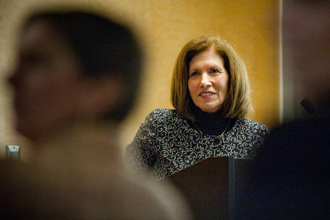Reputation on trial in Victorian murder case
Are reputation and gender relevant in determining the outcome of a criminal trial? In Victorian America, such factors weighed heavily in the murder case of Laura Fair, who is the subject of historian Carole Haber's forthcoming book, Reputation on Trial: Sex, Murder and Insanity in the Victorian West.

Carole Haber, historian and dean of the School of Liberal Arts, talks about her new book at a lecture sponsored by the Gender and Sexualitiy Studies program. (Photo by Paula Burch-Celentano)
In the book, Haber explores Victorian beliefs about women, reputation, sexuality, law and disease through the life and times of Fair, particularly the reaction to her murder trial.
Haber, who is dean of the Tulane School of Liberal Arts and a medical and social historian, spoke about her book on Friday (Jan. 20) as part of an annual lecture and reception sponsored by the Gender and Sexuality Studies program.
When Fair murdered her longtime married lover Alexander Crittenden on a California ferry in 1870, the incident as well as the two subsequent trials of Fair gained national attention.
“The case became a forum for discussing the issues of the day: the status of the medical profession, the suffrage movement, the gendered legal system and the role of reputation in America,” said Haber.
The jury in the first trial found Fair guilty, but the verdict was so heavily based on her perceived reputation that the verdict was nullified. “An individual's reputation was the best way to determine his or her place in society,” said Haber.
As the second trial began, however, this notion of reputation unraveled very publicly as infidelities of doctors, lawyers and others in high society was revealed. As Haber explained, “Laura's case vividly demonstrated the fallacy of relying on a person's public face.”
The annual lecture provides a forum for members of the Gender and Sexuality Studies program to gather. Nancy Maveety, director of the program, said Haber's lecture “is a great centerpiece for examining the current and future direction” of the program.
